10 Martin Kippenberger Untitled 1984 oil, silicone on canvas 48 x 78 3/4 in. (121.9 x 200 cm)
Provenance Collection of Albert Oehlen Germany, acquired directly from the artist Thomas Ammann Fine Art, Zurich Private Collection Exhibited Madrid, Palacio de Velazquez, Museo Nacional Centro de Arte Reina Sofia, Kippenberger: Pinturas, October 20, 2004 - January 10, 2005 Zurich, Thomas Ammann Fine Art, Martin Kippenberger June 2 - September 30, 2009 Literature Kippenberger: Pinturas, exh. cat., Palacio de Velazquez, Museo Nacional Centro de Arte Reina Sofia, Madrid, 2005, p. 128 (illustrated) Martin Kippenberger exh. cat., Thomas Ammann Fine Art, Zurich, 2009, no. 1, p. 1 (illustrated) Catalogue Essay "...the stupidest things suddenly turned into something quite individual. It’s such a comic process. Always get to the heart of the matter, to things that are so close that you wouldn’t think of them. Like an egg, or that sort of thing, and mess about with that ... You don’t have to painstakingly pull things apart, discover something somewhere or other. Some things are never used up because there’s still so much in them" Martin Kippenberger “I drew my way through all the art books on the book shelves. That helped me to see things more clearly than if I'd just looked at the pictures.” Martin Kippenberger In Martin Kippenberger's widely varying work, which includes sculpture, painting, and collage, one finds so little consistent conventionality in his visual manifestations that it has befuddled art critics and observers alike, calling into question the very meaning of artistic creation. Kippenberger has deconstructed and reconstructed symbolic representation the way city planners rebuild war-torn neighborhoods, offering contemporary perspectives on new societies. The artist painted this iconic image of what first appears to be an alienating institutional structure in 1984, a year which is also the title of George Orwell’s book in which institutions play a defining role in reshaping the personalities of its characters. The mid 1980’s saw increased tensions between the superpwers during the second phase of the Cold War. Kippenberger’s life and travels in Berlin as well as in the United States exposed him to the propaganda emanating from institutions on both sides of the Berlin Wall. With an aesthetic, hyper-sensitivity, he witnessed firsthand the effects of this propaganda on the nation’s individuals. Below Kippenberger’s fiery Armageddon in the present lot, Untitled, 1984 lies a seemingly unassuming concrete building, formed by alternating light and dark patches of grey. Echoing the contemporary tenets of modernist architecture, this construction is none other than the Betty Ford Clinic, opened in 1982, just two years before Kippenberger’s painting was realized. Portrayed in a variety of geometrical shapes, Kippenberger upends the intentionally calming facets of the real-life alcohol and drug treatment center, turning each section into an interlocking piece of a nightmarish, metaphorical prison. Kippenberger manages to insert flourishes of flesh tones and yellow onto the walls of building, hinting at a building unduly aged by virtue of the emotional burden of addiction within, while referencing older and alienating buildings he grew up with in Germany: the post-war apartments in the west and the soviet-style bloc housing to the east. In what may first appear as a distinctly representational work, the present lot, Untitled, 1984, stirs with a psychological tension beneath the surface, fusing figurative and abstract expressionist styles. Here, we see a brilliant balancing act between communism and capitalism, the dominating two ideologies that sent many of its citizens to respective institutions of rehabilitation and reeducation. Like the two sides of the then divided Germany, like the fragmented self of the artist, and the fractured psyches in the clinic, this painting is divided into two canvases. The artist united the two canvases with a wooden support system, on top and on bottom, echoing the support system given to the brok
10 Martin Kippenberger Untitled 1984 oil, silicone on canvas 48 x 78 3/4 in. (121.9 x 200 cm)
Provenance Collection of Albert Oehlen Germany, acquired directly from the artist Thomas Ammann Fine Art, Zurich Private Collection Exhibited Madrid, Palacio de Velazquez, Museo Nacional Centro de Arte Reina Sofia, Kippenberger: Pinturas, October 20, 2004 - January 10, 2005 Zurich, Thomas Ammann Fine Art, Martin Kippenberger June 2 - September 30, 2009 Literature Kippenberger: Pinturas, exh. cat., Palacio de Velazquez, Museo Nacional Centro de Arte Reina Sofia, Madrid, 2005, p. 128 (illustrated) Martin Kippenberger exh. cat., Thomas Ammann Fine Art, Zurich, 2009, no. 1, p. 1 (illustrated) Catalogue Essay "...the stupidest things suddenly turned into something quite individual. It’s such a comic process. Always get to the heart of the matter, to things that are so close that you wouldn’t think of them. Like an egg, or that sort of thing, and mess about with that ... You don’t have to painstakingly pull things apart, discover something somewhere or other. Some things are never used up because there’s still so much in them" Martin Kippenberger “I drew my way through all the art books on the book shelves. That helped me to see things more clearly than if I'd just looked at the pictures.” Martin Kippenberger In Martin Kippenberger's widely varying work, which includes sculpture, painting, and collage, one finds so little consistent conventionality in his visual manifestations that it has befuddled art critics and observers alike, calling into question the very meaning of artistic creation. Kippenberger has deconstructed and reconstructed symbolic representation the way city planners rebuild war-torn neighborhoods, offering contemporary perspectives on new societies. The artist painted this iconic image of what first appears to be an alienating institutional structure in 1984, a year which is also the title of George Orwell’s book in which institutions play a defining role in reshaping the personalities of its characters. The mid 1980’s saw increased tensions between the superpwers during the second phase of the Cold War. Kippenberger’s life and travels in Berlin as well as in the United States exposed him to the propaganda emanating from institutions on both sides of the Berlin Wall. With an aesthetic, hyper-sensitivity, he witnessed firsthand the effects of this propaganda on the nation’s individuals. Below Kippenberger’s fiery Armageddon in the present lot, Untitled, 1984 lies a seemingly unassuming concrete building, formed by alternating light and dark patches of grey. Echoing the contemporary tenets of modernist architecture, this construction is none other than the Betty Ford Clinic, opened in 1982, just two years before Kippenberger’s painting was realized. Portrayed in a variety of geometrical shapes, Kippenberger upends the intentionally calming facets of the real-life alcohol and drug treatment center, turning each section into an interlocking piece of a nightmarish, metaphorical prison. Kippenberger manages to insert flourishes of flesh tones and yellow onto the walls of building, hinting at a building unduly aged by virtue of the emotional burden of addiction within, while referencing older and alienating buildings he grew up with in Germany: the post-war apartments in the west and the soviet-style bloc housing to the east. In what may first appear as a distinctly representational work, the present lot, Untitled, 1984, stirs with a psychological tension beneath the surface, fusing figurative and abstract expressionist styles. Here, we see a brilliant balancing act between communism and capitalism, the dominating two ideologies that sent many of its citizens to respective institutions of rehabilitation and reeducation. Like the two sides of the then divided Germany, like the fragmented self of the artist, and the fractured psyches in the clinic, this painting is divided into two canvases. The artist united the two canvases with a wooden support system, on top and on bottom, echoing the support system given to the brok
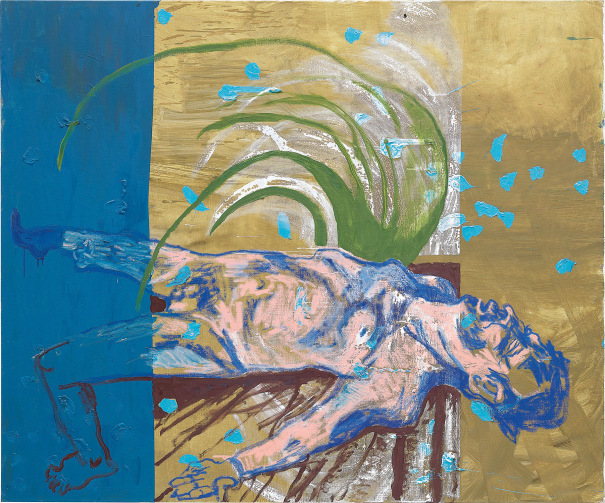
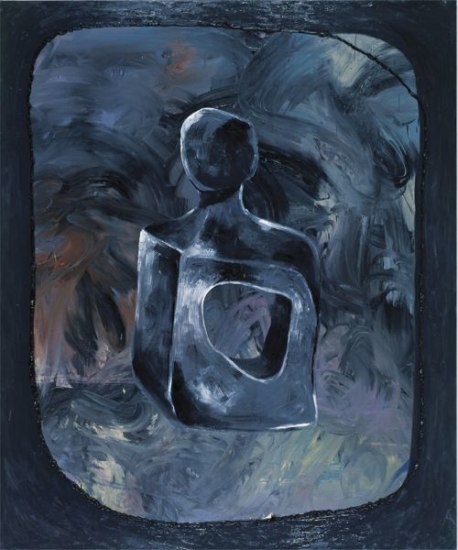
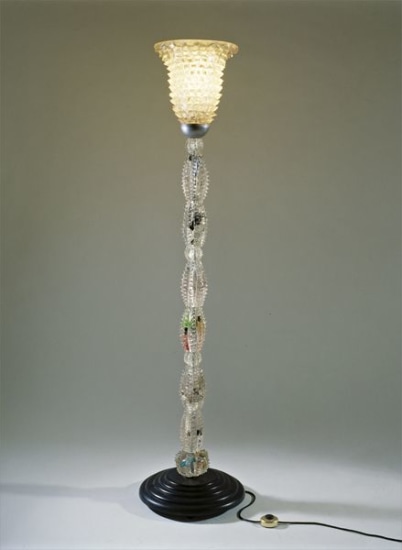

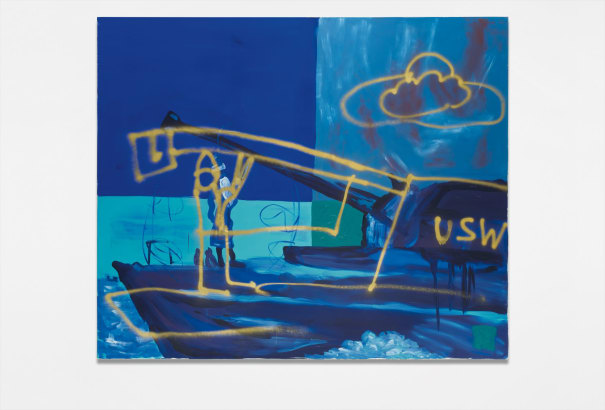



.jpg)



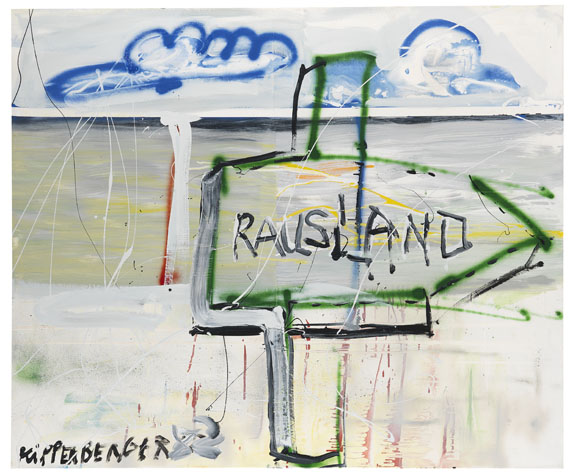
Try LotSearch and its premium features for 7 days - without any costs!
Be notified automatically about new items in upcoming auctions.
Create an alert